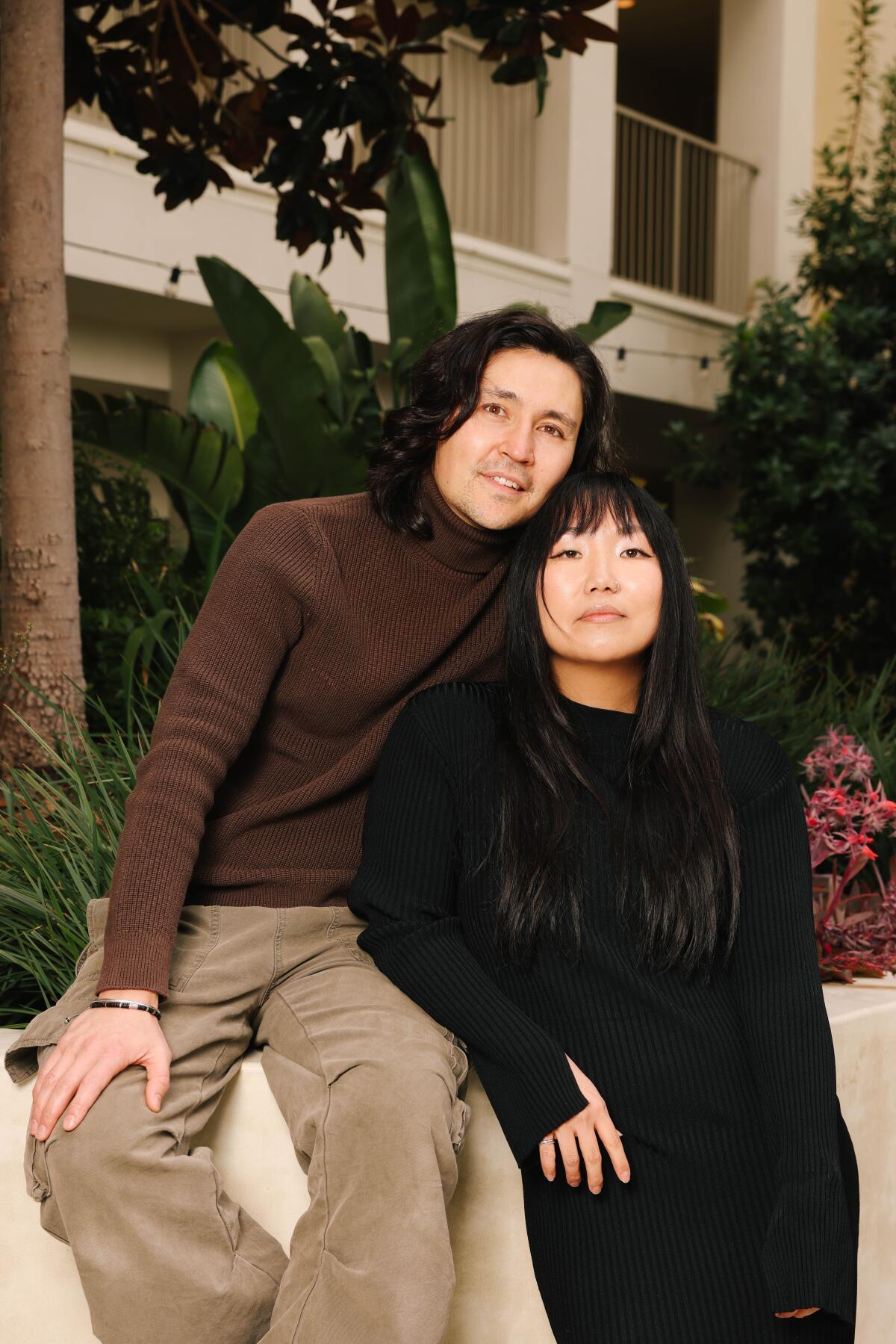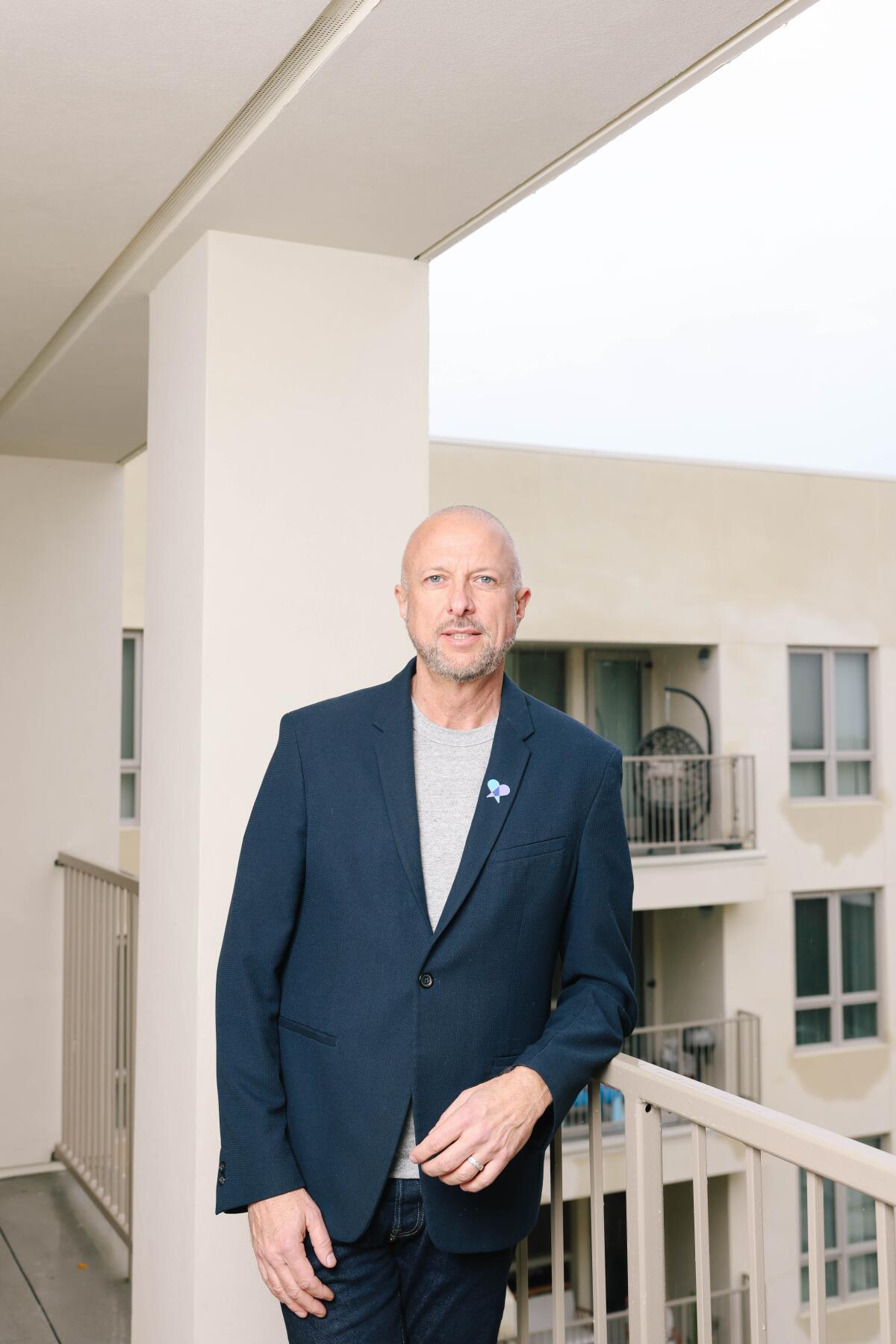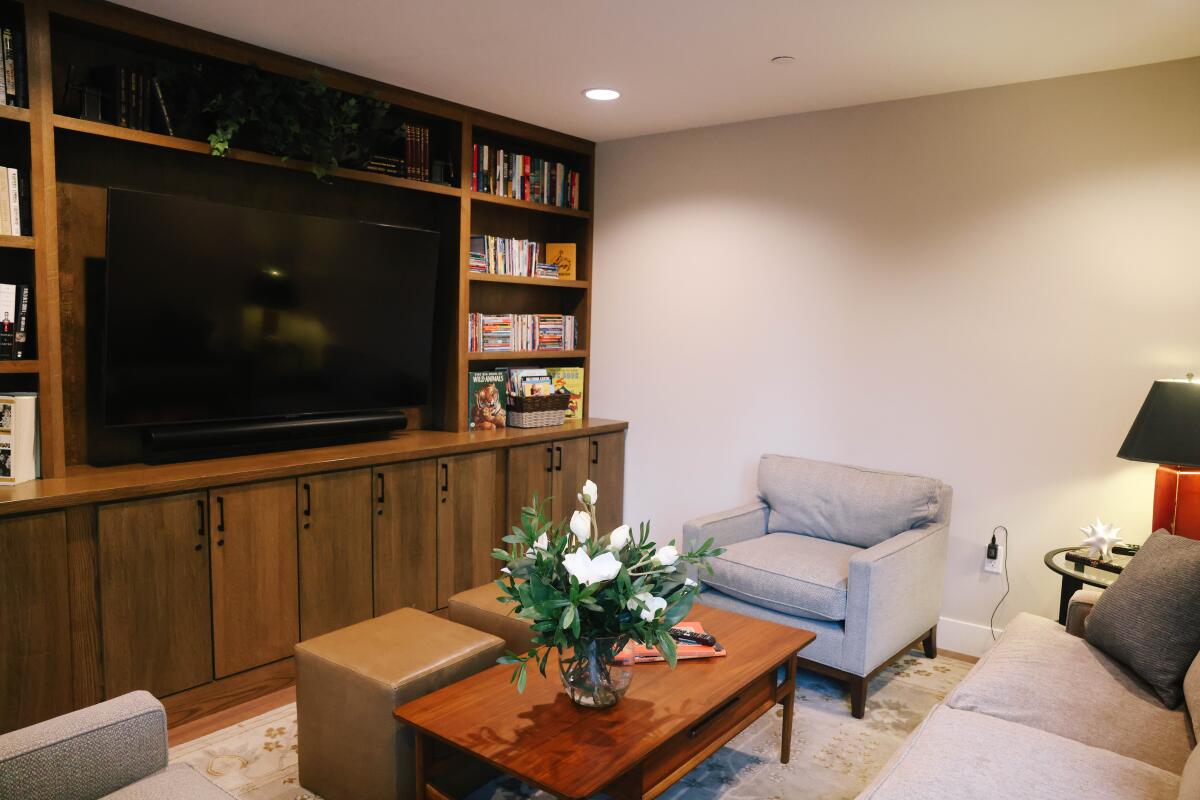Tatyana Kim and her husband Anatoliy O immigrated to Los Angeles from Almaty, Kazakhstan, 12 years ago in pursuit of the Hollywood dream.
When the filmmaking duo first arrived in the United States, they scraped by, living in small rooms and back houses in Pasadena while studying their crafts at L.A.-area arts colleges.
They eventually upgraded to a rent-controlled apartment in Hollywood, where they paid $1,500 a month to share a single bedroom with their infant daughter. At the nearby TCL Chinese Theatre, the couple would eat oatmeal for dinner while waiting in line for movie screenings.
But even that relatively low housing cost was a stretch for independent artists trying to make it in an increasingly challenging industry while taking care of a young child and juggling extra film and commercial producing gigs to pay the bills.
“Let’s just be transparent,” O said. “Most artists who I know are having a day job. That’s the reality of it. There’s no way around it.”
Luckily, they found relief. Now, the couple pays $870 a month for a different apartment with a bedroom for themselves, a separate room for their daughter and a 10-feet-by-10-feet office space for their editing bays, assorted music and filmmaking equipment and a dedicated wall for self-taped auditions. They signed the lease for their new home the day their Oscar-qualifying short film screened at the Chinese Theatre.
“I literally tell everyone this story because people don’t believe in miracles,” Kim said. “But we truly think that we manifested this.”
Kim, a 37-year-old writer-director, and O, a 36-year-old writer and actor, are among the first residents of the Hollywood Arts Collective, a new affordable housing complex that caters to people working in the arts and entertainment industries.

Hollywood Arts Collective residents Anatoliy O and Tatyana Kim met while working on a production of “Grease” at an English-language playhouse in their native Kazakhstan. Kim choreographed the show and O played Danny Zuko.
(Dania Maxwell / Los Angeles Times)
The 10-story building financed by the Entertainment Community Fund — a nonprofit organization formerly known as the Actors Fund that provides financial aid and other resources to entertainment workers around the country — officially opened in March and began housing residents in late April, two days before the Writers Guild of America kicked off a six-month season of strikes that put thousands out of work.
Applicants must prove they work in a creative field and make up to 80% of the area median income in order to qualify for residency. The complex offers flexible rent prices between 30% and 50% of tenants’ monthly income.
The need for such a haven in the arts and entertainment community could not have been more urgent.
The Entertainment Community Fund received about 15,000 applications to move into the collective, which it whittled to about 5,600 for lottery selection to fill 151 units. The waitlist has been capped at roughly 3,500 applicants, reflecting long-term challenges for the local entertainment economy.
The overlapping writers’ and actors’ walkouts spurred a near-total production shutdown, dealing an estimated $6-billion blow to the California economy and causing the entertainment employment rate in the greater Los Angeles area to plummet by 17%, according to a report released in December by the Otis College of Art and Design.
Meanwhile the cost of living in L.A. — already one of the most expensive cities in the United States — is going up.
According to CVL Economics, the firm behind the Otis College Report on the Creative Economy, roughly 45% of arts and entertainment workers in Los Angeles are rent-burdened, meaning that more than 30% of their income is spent on housing. And 38% of arts and entertainment workers in the region live in households at or below the Department of Housing and Urban Development’s definition of low income.
Consequently, an increasing number of film and TV productions are choosing to film elsewhere in large part because housing in Los Angeles is too expensive for the people employed on those projects, said Don Sutton, a real-estate professor who teaches at UCLA and Cal State L.A.
And because much of L.A. filming activity takes place in some of the priciest areas, many employed on local productions endure long commutes because they can’t afford to live where they work. All of this is compounded, Sutton continued, by the fact that established residents of L.A. production hubs tend to oppose the construction of affordable housing in those areas.
The Hollywood Arts Collective is the only building in Los Angeles that specifically serves low-income arts and entertainment workers, according to the fund. By the time it’s finished, the project will also include a 71-seat theater, a visual arts gallery, rehearsal rooms, a recording studio and training spaces where residents will be able to receive mental health support, career counseling, financial education and other services.
The Entertainment Community Fund is planning to complete a second apartment building on the site by the end of 2025, plus five additional affordable housing complexes for entertainment and arts workers in Los Angeles County over the next 10 years.
“We really want people to have time and free access to places where they can practice their craft … without driving their neighbors crazy,” said Keith McNutt, executive director of the Entertainment Community Fund’s western branch. “We want everybody to be peaceful and happy.”
Because the site is owned by the Los Angeles Department of Transportation, the developers of the Hollywood Arts Collective entered into a 99-year lease that costs them about $1 annually to use the land, making the project affordable long-term. The federal government’s Low-Income Housing Tax Credit Program covers much of the cost of construction, and rent paid by residents is enough to take care of the rest.
“Those 151 arts workers and their families represent 60-plus professions in every kind of arts you can imagine,” McNutt said. “It’s really a stake in the ground for the creative community in Los Angeles to have a significant, permanent place for lower-income arts workers to stabilize their lives, live in a nice place and really focus their work on their careers.”

Keith McNutt, the executive director of Entertainment Community Fund’s western branch who helped oversee the development of the Hollywood Arts Collective, poses for a portrait at the residence.
(Dania Maxwell / Los Angeles Times)
So far, residents say, the collective appears to be living up to its name, functioning as both an affordable living space and a creative environment where tenants can socialize and collaborate.
Before moving into the development, Ethan Rodriguez oscillated between couch-surfing and living out of his car while attending auditions and working for a moving company to make ends meet.
The 27-year-old actor and model, who relocated to L.A. from Denver, eventually saved up enough money to rent a studio apartment in Hollywood for $1,200, where he stayed for about a year before applying to live at the affordable housing complex.

Ethan Rodriguez was one of the first people to move into the Hollywood Arts Collective. The actor and model dreams of playing Superman onscreen one day. “He comes and saves people, and that’s me,” Rodriguez said. “I’m going to be the next Superman.”
(Dania Maxwell / Los Angeles Times)
Rodriguez stumbled upon the Hollywood Arts Collective while walking to the gym where he regularly exercises in preparation for the opportunity to play his dream role, Superman, should it ever arise. Signs outside the apartment complex — which was still under construction at the time — said that “it was for people in the industry who needed a helping hand,” Rodriguez recalled.
“And I needed one at the time.”
Rodriguez currently resides in a single-bedroom unit at the complex that costs him about $635 a month. Shortly after moving in, Rodriguez made his first friend in the building — a painter who works in Venice Beach — while showing him how to use the laundry machines. He’s since met several other creative neighbors in the elevator and the common area, where residents gather for monthly pizza parties.
During one of the common-area hangouts, Rodriguez struck up a conversation with a photographer who inquired about his work and offered him tips on how to be a successful runway or fitness model (the key: Don’t try to be both).
Rodriguez said it was particularly validating to be surrounded by other arts and entertainment professionals during the strikes, “when finding work was a little more difficult.” Although he isn’t a member of the Screen Actors Guild-American Federation of Television and Radio Artists, Rodriguez steered clear of certain job opportunities to avoid crossing the picket line and hurting his chances of obtaining union membership in the future.
“[Another resident] had told me they had been out of work for a while, and that was comforting to me,” Rodriguez said. “Not because he hadn’t been at work, but because I hadn’t been at work either.”

Hollywood Arts Collective resident Ethan Rodriguez said that living around other arts and entertainment workers reminds him that he’s “not the only one going through things” and “it’s gonna be OK.”
(Dania Maxwell / Los Angeles Times)
Kim and O came across the application for residency while poring over the grants and opportunities section of an arts newsletter.
The couple has collaborated on about 10 stage productions, 20 commercials and a handful of films, including the short film “Off Hollywood: The Undocumented Journey of Hope,” starring O as a half-Korean, half-Russian immigrant from Kazakhstan struggling to make it as a musician in Los Angeles.
The semi-autobiographical project is the couple’s love letter to the neighborhood they’ve called home for nearly 10 years, as well as to fellow immigrant artists.
Also featured in the film is their daughter, who was delivered inside their previous apartment so that O could be present for the birth without breaking COVID-19 protocols at the hospital. The living room doubled as a makeshift office for the couple and a play area for their child.
“That space … still means a lot to us,” Kim said. “It was very old. We did not have space. But we still managed to create things there.”

Part of the common area at the Hollywood Arts Collective where there are monthly pizza parties intended to celebrate residents’ birthdays. “Just in January, there were like 10 or 15 people” celebrating birthdays, said one resident, Anatoliy O. “I’m like, ‘Everybody’s a Capricorn?!’”
(Dania Maxwell / Los Angeles Times)
Kim and O have befriended some of their neighbors too, including a graphic designer whose twins attend daycare with their daughter.
The neighborly interactions, however fleeting, have provided residents with a sense of inspiration and reassurance in hard times — especially during the writers’ and actors’ strikes. O said it was encouraging to see fellow actors in the elevator sporting their SAG-AFTRA T-shirts while going to and from the picket lines.
“They’re like our family now,” Kim said.





